Charming Paint Colors to Transform Your Living Room
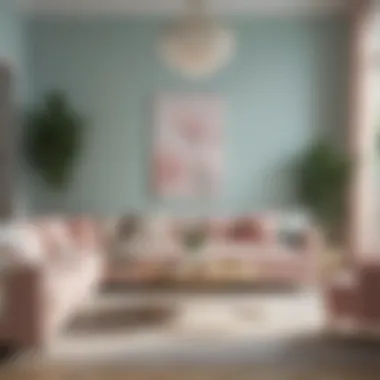
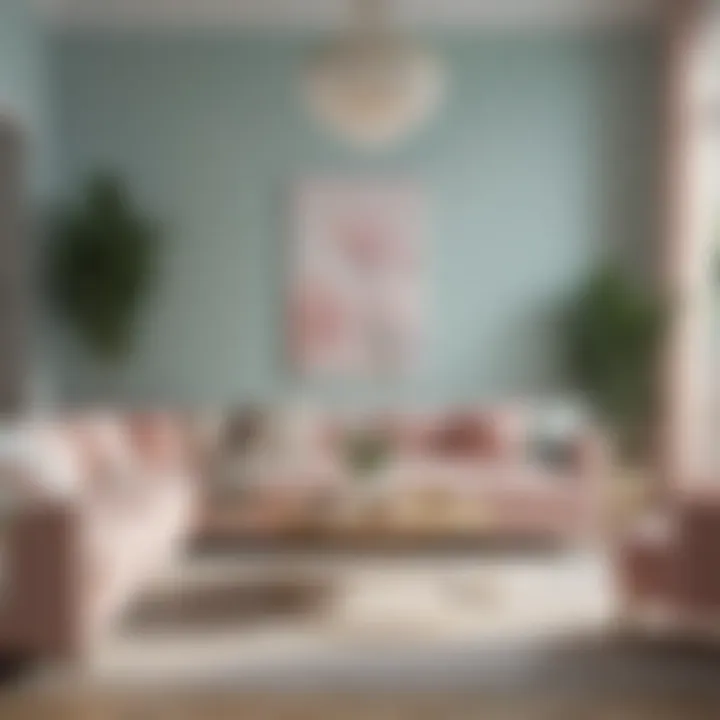
Intro
The color palette of a living room holds more significance than one might initially consider. It sets the tone for not only the space itself but also influences the emotional response of those who dwell within it. Selecting relaxing paint colors can transform a typical living room into a serene escape, essential for fostering relaxation and comfort. This article will dive into the psychological effects of color choices, explore recommended shades, and provide practical tips for applying these color strategies effectively.
Design Inspiration
Creating a relaxing environment begins with understanding current design trends and effective color palettes. A thoughtful selection of paint colors can significantly enhance the ambience, resulting in a calm and inviting living space.
Trending Styles
Recent trends showcase a shift toward softer hues that evoke tranquility. Popular styles include minimalist aesthetics and soothing nature-inspired themes. Here are a few prevalent styles:
- Scandinavian: Emphasizes light colors like soft whites, pale grays, and muted pastels. This style promotes simplicity and a clutter-free atmosphere.
- Bohemian: Utilizes earth tones and soft greens that reflect nature, paired with vibrant accents.
- Modern Farmhouse: Combines light neutral colors with dark wooden elements, creating warmth alongside elegance.
Color Palettes
When considering specific shades, certain colors are renowned for their relaxing qualities. Here are some effective palettes to contemplate:
- Soft Blue: Known for its calming properties, soft blue fosters a sense of peace. This color also works well with natural lighting.
- Pale Green: Mimicking the tranquility of nature, pale green hues enhance a feeling of relaxation and comfort.
- Warm Beige: A neutral tone that can create a cozy atmosphere, making it versatile when paired with various furnishings.
- Lavender: Soft lavender tones promote serenity, especially in a well-lit room.
"Color is the keyboard, the eyes are the harmonies, the soul is the piano with many strings." - Wassily Kandinsky
Practical Tips
To optimize your living room's relaxing potential through color, certain practical aspects must be considered. From maintenance to budgeting, each detail contributes to the overall integrity of the space.
Maintenance & Care
Selecting a paint that is easy to maintain is crucial. Here are recommendations:
- Eggshell Finish: This finish is slightly glossy, making it easier to clean without compromising texture or color.
- Washable Paints: These facilitate easy cleaning, essential for a space often used for gathering.
Budgeting & Planning
Before undertaking a color change, having a clear budget is vital. A few strategies include:
- DIY vs. Professional Help: Weighing whether to tackle painting yourself or hire professionals can greatly affect costs.
- Sample Sizes: Purchase paint samples to test colors in your living room's lighting before making larger purchases.
- Plan Seasonal Changes: Repainting can be an evolving project that adapts to seasonal changes. Consider gradual updates that keep within budget while refreshing your space.
Choosing the right relaxing paint colors is a journey that merges aesthetics with psychological benefits. By following the insights outlined in this article, homeowners and design enthusiasts alike can create a living room that truly embodies relaxation.
Understanding the Impact of Color
The colors we choose for our living rooms can greatly influence our mood and perception of space. Understanding the impact of color helps homeowners make informed decisions that contribute to a peaceful atmosphere. Color has been shown to affect emotions, productivity, and even how we relate to our environment. In this section, we will delve into the significance of color psychology and the role colors play in interior design.
Color Psychology and Its Influence
Color psychology examines how different hues can have various effects on human emotions. For example, soft blue shades evoke feelings of tranquility and calmness. Many people find that blue can be a soothing presence, making it an excellent choice for living rooms where relaxation is key. On the other hand, bright and bold colors may stimulate energy and enthusiasm, which may not be ideal for a serene environment.
When selecting color for your living room, consider how each shade communicates a certain mood. Warm colors like soft yellows can promote feelings of comfort, while greens may instill a sense of balance and peace.
"The choice of color can set the emotional tone of the space, influencing how we feel when we enter a room."
The Role of Color in Interior Design
In interior design, color is more than just an aesthetic choice; it influences spatial perception and flow. Lighter colors can make a room feel larger and airier, suitable for smaller living spaces. Darker shades can add depth and coziness, which may be desirable in larger areas meant for gathering.
Additionally, colors can complement or contrast with furniture and decor, enhancing the overall ambiance. For a harmonious living room, it is essential to consider how wall colors interact with flooring, furniture, and accessories. This organized interplay of colors can stabilize the space and foster a welcoming environment.
In summary, understanding color's impact can guide you in creating a living room atmosphere that reflects relaxation and comfort.
Identifying Relaxing Colors
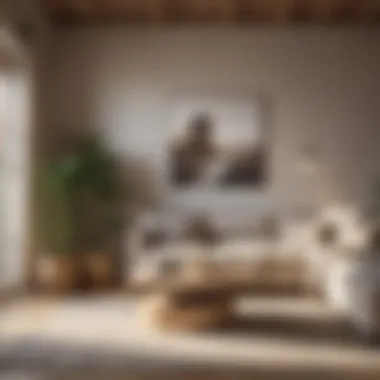
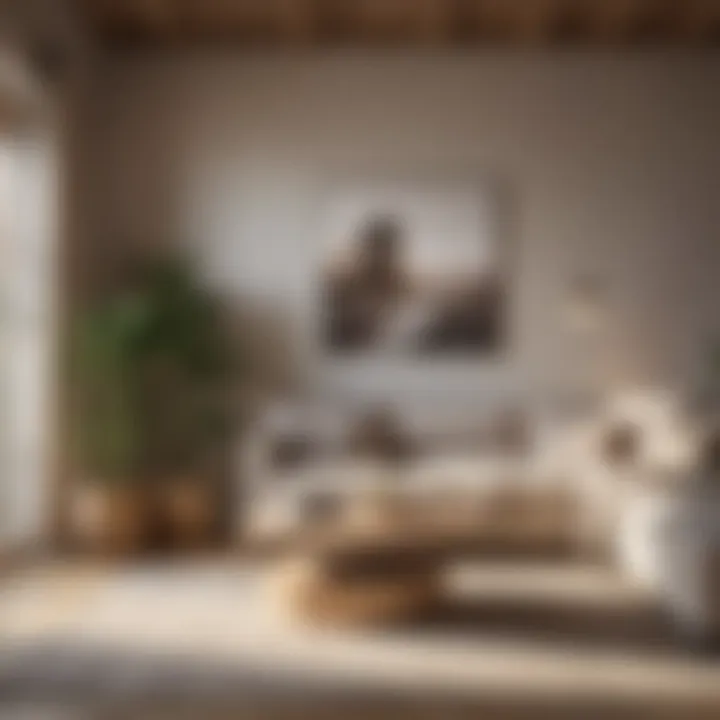
Identifying relaxing colors is crucial in creating a peaceful atmosphere in any living room. This section delves into specific shades and hues that promote serenity and comfort. Selecting the right colors can transform an ordinary space into a calming sanctuary. The choices we make in color have direct impacts on our mood and well-being, and that is why understanding these elements is essential for any homeowner or design enthusiast.
When choosing relaxing colors, consider such factors as personal preference, natural light in the room, and the existing furniture. Each color offers unique qualities and emotional responses, making informed selections vital. By pinpointing relaxing shades, homeowners have the opportunity to cultivate a space that feels inviting and tranquil.
Nebulous Charcoal Grays
Nebulous charcoal grays serve as an excellent choice for creating relaxation in a living room. This color is versatile and pairs well with both light and dark accents. It encourages a feeling of coziness without overwhelming the senses. Charcoal gray’s neutrality allows it to complement various design styles, from modern minimalism to traditional settings, enhancing all the elements of interior decor.
Furthermore, shades of gray can be adjusted by the amount of light reflecting in the room, capturing warmth in daylight and deepening in the evening hours. A soft charcoal gray can ground a living space, offering a warm backdrop for furniture and artwork to stand out gracefully.
Soft Blues for a Calm Effect
Soft blues are celebrated for their calming and serene effects. Known for invoking feelings of tranquility, light blue shades can create a refreshing, open feel in a living room. This color reminds of serene skies and peaceful waters, effectively lowering stress levels and promoting relaxation.
Different tones, such as sky blue or powder blue, can be incorporated to customize the atmosphere. When combined with white furnishings or light wood, soft blues can make a space feel airy and expansive, an ideal characteristic for modern homes. Keeping accents in soft blues consistent will enhance their soothing properties.
Pale Greens for a Natural Touch
Pale greens offer an essential link to nature, helping to foster a calming atmosphere indoors. This color embodies renewal, growth, and balance, providing a sense of harmony that is vital for relaxation. Soft shades of green like mint or sage work well as wall colors, creating a refreshing backdrop.
Integrating pale greens with natural textures such as wood or stone can further amplify that tranquil feeling. This combination not only links the living room to the outdoors but also creates a balanced environment. Many homeowners find that pale greens promote feelings of calmness and well-being, qualities that are necessary in a living space that serves as a retreat.
Warm Neutrals to Ground a Space
Warm neutrals, such as beige, taupe, and soft brown, present a grounding effect in the living room. These colors provide warmth and comfort, making them ideal choices for creating a serene atmosphere. Neutral tones allow for versatility and adaptability, lending themselves easily to various decoration styles.
When selecting warm neutrals, the key is to choose shades that complement one another. Combining these hues with textures—like textiles and furniture pieces—further enriches the sensory experience in the room. Their understated elegance helps create an inviting space that can be accessorized with bolder colors without causing visual conflict.
Harmonizing Color with Natural Light
Understanding how color interacts with natural light is crucial in creating a relaxing living room ambiance. Light affects how colors are perceived. Different times of day can change how a paint color looks. A well-planned approach ensures that the color palette harmonizes with the available light, enhancing the desired restful atmosphere.
Assessing Natural Light Sources
The first step is to evaluate the natural light sources in your living space. Consider the direction of the windows. South-facing rooms receive a lot of sunlight, especially in the afternoon. This can wash out lighter colors and result in a warmer ambiance. North-facing spaces tend to get cooler light, which may enhance the soothing effect of soft blues and greens. Additionally, the presence of trees or buildings nearby may cast shadows, affect the brightness, and alter color perception.
The time of day also matters. Morning light has a different quality compared to the golden hour before sunset. Take note of how your color choices look at various times. Testing the paint on the walls helps in making informed decisions.
Adapting Colors to Different Lighting Conditions
Adapting colors to suit different lighting conditions is essential for ensuring a consistent atmosphere. Shades that look pleasant during the day might appear drastically different at night. For example, a soft pastel may seem too bright or even garish when illuminated by artificial lighting.
Here are some tips to achieve effective adaptation:
- Choose Muted Tones: Muted shades tend to adapt well to varying light conditions. They achieve a balance between brightness and calmness.
- Consider Undertones: Warm undertones in colors will radiate differently under various light sources, so selecting colors based on their undertones is necessary.
- Mix and Match: Use a combination of colors that can complement each other under different lighting situations. For example, pair a warm peach with a cool gray to provide flexibility across different times of the day.
As you plan your living room’s colors, keep the interplay between paint and light at the forefront. This consideration will elevate the space's comfort and relaxation potential.
"Color is the keyboard, the eyes are the harmonies, the soul is the piano with many strings." - Wassily Kandinsky
Incorporating these insights allows for a thoughtful cohesive design that maximizes the benefits of natural light.
Choosing the Right Finishes
The choice of finish in paint application plays a significant role in achieving the desired effect in a living room's atmosphere. Finishes not only affect the aesthetic appeal but also influence how light interacts with the walls. Matte and glossy finishes provide distinct looks and functional properties that can greatly impact a room's overall feel. When selecting materials, it is crucial to consider the ambiance one wishes to create. Moreover, the way finishes affect maintenance and durability can guide choices accordingly.
Matte vs. Glossy Finishes
Matte finishes are often favored for their soft, non-reflective look. They are ideal for creating a tranquil and cozy atmosphere in the living room. This finish tends to hide imperfections on the wall, making it a good option for older surfaces. However, matte paints can be more challenging to clean, so they require careful consideration in high-traffic living areas.
On the other hand, glossy finishes reflect more light and provide a smoother texture. This can make a space look brighter and more inviting, but they also highlight wall imperfections. A gloss level can add depth and vibrancy to relaxing colors, which may suit modern design preferences. It is also easier to wipe clean, making it practical for spaces like the living room where spills can occur.
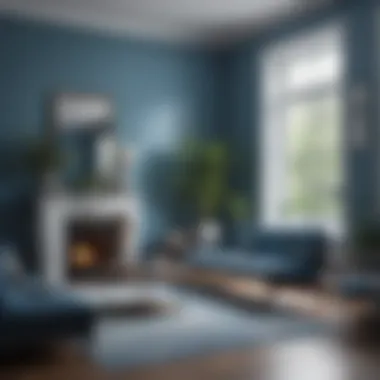

Textured Paint Options
Textured paint introduces an additional layer of interest to a living room. This option allows for a unique sensory experience beyond color alone. Textured finishes can create depth and nuance, which can be soothing for some individuals. Techniques such as sponging, rag rolling, or using specialized rollers can apply textures.
These options can soften the overall look of a room while still emphasizing relaxing shades like soft blues or pale greens. The hand-applied appearance often adds character, creating a cozy environment that appeals to many homeowners and design enthusiasts. Consideration of what complements the furnishings and accessories is essential when selecting textured options.
In summary, choosing the right finish is critical for achieving intended visual and tactile outcomes in a living room. Each option, whether matte or glossy, must align with personal preferences and the room's overall functionality. Being aware of these factors enhances the project and elevates the space into a true reflective sanctuary.
Painting Techniques for a Calming Atmosphere
Creating a soothing living space is essential in promoting relaxation and comfort. The right painting techniques can enhance the overall mood of a room, making it an ideal environment for unwinding. By applying consistent colors and thoughtful designs, homeowners can establish a calming atmosphere that reflects their personal style while fostering a sense of peace.
Consistent Color Application
Maintaining consistency in color application is critical for a unified look. This means selecting a palette that resonates with the desired mood. Using a limited color scheme can help avoid confusion and create coherence. For instance, if an individual chooses soft blue hues, it is beneficial to stick to various shades of blue throughout the space. Small changes in brightness are acceptable and can add visual interest without creating dissonance.
In addition, the technique of applying paint consistently contributes to the perception of space. Smooth, even applications can make walls appear sculpted, thereby enhancing tranquility. Consideration of surface texture also plays a role in color perception. A well-prepared surface will showcase color more vibrantly, which can affect how calming or energizing the chosen shade feels.
Accent Walls for Depth
Accent walls are another effective technique to create depth and interest in a living room. By painting one wall in a contrasting or complementary color, it draws attention and creates a focal point. This approach can be particularly beneficial when dealing with neutral living rooms. A deep green accent wall, for example, can bring in a touch of nature and provide a contrasting background to lighter shades.
Moreover, accent walls can define different areas within the same space. This adds functionality while preserving an inviting atmosphere. Choosing calming colors for accent walls, such as muted blues or soft grays, can enhance the overall restful quality of the living area. For those specific about their color choice, opting for low-sheen finishes on accent walls may soften light reflections, further benefiting the calming ambiance.
In summary, effective painting techniques such as consistent color application and the strategic use of accent walls are integral in crafting a calming atmosphere in a living room.
Integrating Color with Furniture and Decor
Integrating color with furniture and decor is fundamental in establishing the desired atmosphere in a living room. Color choices should not exist in a vacuum; they must work in tandem with the furnishings and accessories within the space. When these elements harmonize, they create a cohesive environment that can enhance relaxation and comfort.
One benefit of thoughtful color integration is the potential to streamline the aesthetic of a room. For instance, selecting furnishings that reflect or complement the wall color can make a space feel larger and more inviting. Using complementary colors can draw the eye and create a pleasant visual flow. Likewise, consistency in color throughout different elements can establish a sense of unity, making the room feel complete.
Another consideration is how color interacts with various materials. Different textures can absorb or reflect color differently. For example, a matte finish may appear softer and more calming than a glossy surface, which might reflect light and create a more lively feel. Thus, understanding these dynamics is essential for integrating color effectively.
Selecting Complementary Furnishings
The selection of complementary furnishings is vital in achieving a harmonious look. It involves matching or coordinating furniture colors with the room's paint. For example, if the living room walls are painted in a soft blue, then selecting upholstery or tables in shades of white, beige, or even darker navy can create balance. Texture also plays a critical role here. A wooden coffee table can add warmth against cooler wall colors, effectively marrying the two.
When choosing furniture, consider the tone of the color you have picked. Softer hues can benefit from light woods or airy fabrics, thus keeping the atmosphere lighthearted. In contrast, deeper shades may lend themselves well to heavier materials or darker finishes, creating a more intimate space.
"The right furnishings can either uplift or ground the existing color scheme, making them essential in creating a relaxing atmosphere."
Incorporating Textiles and Accessories
Incorporating textiles and accessories can further enhance the integration of color within a living room. This can be done through the use of area rugs, throw pillows, curtains, and other decorative items. Each of these elements not only adds comfort but also serves as an opportunity to introduce more color variations.
For instance, if the walls are painted pale green, adding accessories in deeper greens or muted earth tones can create layers within the space. Textiles are also a great way to experiment with textures that can contrast with the painted surfaces. Soft pillows in fabric with varied textures can create depth without overwhelming the senses.
Consider the functionality of accessories as well. Curtains can filter light, thus impacting how color appears in the room throughout the day. Therefore, carefully selecting the right fabrics for these items can magnify the relaxing effects of the existing paint colors.
Ultimately, the thoughtful integration of color with furniture and decor fosters an inviting atmosphere in the living room. It elevates the space while ensuring it remains a sanctuary for relaxation and comfort.
Avoiding Overstimulation
Creating a relaxing living room involves more than selecting soothing colors. It requires careful consideration to avoid overstimulation, which can detract from the serene atmosphere intended. Overstimulation occurs when bold colors, busy patterns, or excessive decoration compete for attention, creating a sense of chaos instead of calmness.
Understanding Color Overload
Color overload can lead to a range of negative effects, such as increased anxiety and distraction. It’s essential to recognize how the colors chosen for your living room can influence mood and behavior. A home should serve as a retreat. Too many vibrant hues can create visual noise and may trigger stress responses in some individuals.
When planning your color scheme, it’s wise to limit the number of bright or saturated colors. A palette dominated by neutral or soft shades promotes relaxation and comfort. Consider incorporating only small pops of brighter colors, perhaps through decor or accessories. This way, you can maintain an inviting atmosphere without overwhelming the senses.
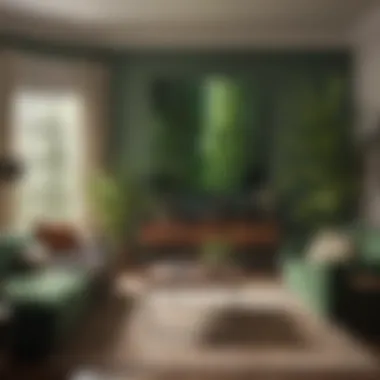
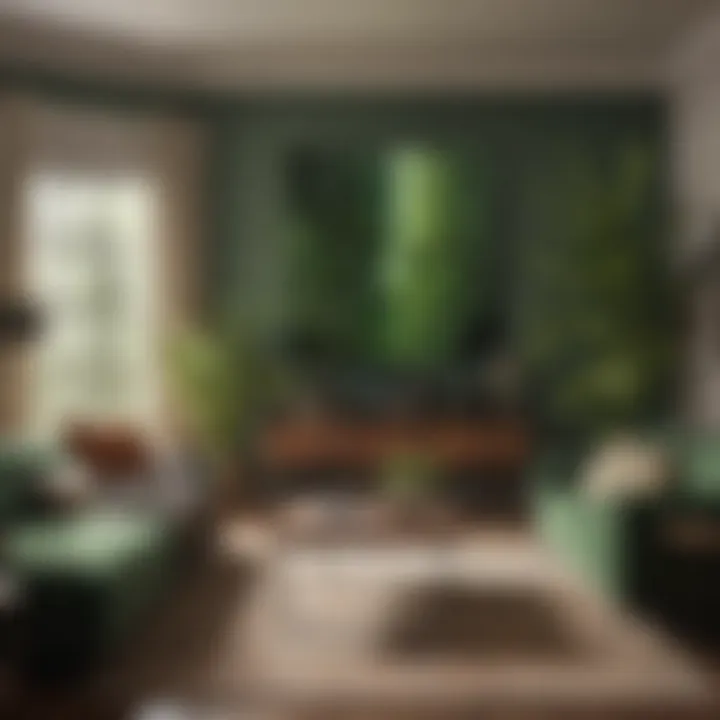
"Effective use of colors can enhance relaxation and comfort in the living area, but care must be taken not to induce stress through excessive stimulation."
Balancing Bright and Calm Hues
Striking the right balance between bright and calm hues can transform a space from overwhelming to inviting. Bright colors have their place—they can energize and uplift—but when used excessively, they can disrupt the peaceful environment.
When integrating bright colors, think about their placement. Use them as accents rather than dominant features. Fabrics like cushions, artwork, or decorative pieces can showcase vibrant hues while keeping the larger surfaces in muted tones. Try to create harmony between bright and soft shades to foster tranquility.
Consider a method of three: a base of a serene color, an accent color, and a neutral tone. This strategy helps in achieving a cohesive look. For example, a soft blue could serve as the main color, paired with bold yellow in accessories, while whites or beiges fill in other areas. These combinations allow for visual interest without overwhelming the space.
Trends in Relaxing Paint Colors
The trends in relaxing paint colors can significantly influence the atmosphere of a living room. Understanding these trends is key to selecting tones that foster calmness and comfort. Each year, color preferences evolve, often reflecting broader societal tendencies or aesthetic shifts. Adapting to these trends enables homeowners and design enthusiasts to create spaces that feel fresh and inviting.
Current color trends often draw from nature, emphasizing earthy tones and soft pastels. These shades can transform spaces into sanctuary-like retreats. Colors such as gentle creams, light blues, and muted greens contribute to a tranquil ambiance. The choice of color can also connect an interior with the outdoor environment. Inspiration from nature leads to a more peaceful living area.
Benefits of Staying Updated with Trends:
- Aesthetic Appeal: Following trends can enhance the visual interest of a room.
- Market Responsiveness: Current trends can increase a home's market appeal if you ever plan to sell.
- Psychological Benefits: Updated colors often cater to contemporary mental well-being considerations, promoting relaxation and comfort.
Considerations for Integrating Trends:
- Determine personal style preferences alongside current trends for a balanced approach.
- Test colors in your space to see how they interact with natural light.
- Mix trendy shades with timeless colors for longevity without sacrificing style.
Current Color Trends
In recent years, certain hues have gained popularity for their soothing qualities. Soft blues, pale greens, and warm neutrals stand out as leading choices. They are not only visually appealing but also conducive to a serene atmosphere:
- Soft Blues: Often associated with tranquility, soft blues can mimic the sky or water, promoting calmness and reflection.
- Pale Greens: These shades can evoke feelings of growth and harmony, connecting the indoors with nature.
- Warm Neutrals: They provide a grounding presence, making spaces feel cozy and inviting.
This year, specific shades like Sherwin-Williams' Sea Salt and Benjamin Moore's Soft Fern persist in popularity. Their subtle tones create universally appealing environments. Additionally, pastels are returning, but with a more muted palette to remain visually gentle.
Timeless Shades for Longevity
While current color trends are important, timeless shades maintain their appeal across years. They situate a living room in a classic realm, providing stability and warmth. These shades, such as warm whites, soft beiges, and muted taupes, have proven effective in various contexts:
- Warm Whites: They expand a room visually while providing a clean slate for decor opportunities.
- Soft Beiges: A versatile option suitable for varying furnishings and styles, offering warmth without overwhelming a space.
- Muted Taupes: This color blends both warmth and neutrality, acting as a perfect background for accents and textures.
By incorporating timeless shades into the living room, one can achieve a balance between current trends and lasting aesthetic. It ensures that your home feels modern yet not excessively tied to fleeting fashions.
A well-chosen paint can define the mood and function of your living space.
Understanding these elements leads to a thoughtful approach in designing a calming environment.
Final Considerations
When selecting relaxing paint colors for your living room, it is crucial to reflect on the various implications of your choices. The living room serves as a central hub for interactions, relaxation, and family activities. Thus, the paint colors you choose can significantly influence the ambiance, in turn affecting mood and comfort.
In this section, we will discuss critical elements including personal preferences, the psychological impact of colors, and practical considerations when making your selections. The benefits of careful color evaluation are profound. By understanding the interaction between color and emotional responses, you can create a living space that fosters serenity and well-being.
Evaluating Your Choices
Before committing to a color palette, assess your personal style and the preferences of those who use the space. A few guiding questions may help:
- What colors resonate positively with you?
- How do you want to feel in this environment?
- Are there any existing elements in the room that will influence your color choice, such as furniture or artwork?
Another key consideration is the psychology of color. Research indicates that certain hues can invoke specific feelings. For example, while soft blues might promote calmness, warm neutrals can stimulate comfort. Reviewing these emotional connections can provide guidance in assessing which colors may best suit your intentions.
Evaluating your choices also involves considering the scale of the room and lighting conditions. A smaller room may benefit from lighter shades to create an illusion of space, while larger areas can accommodate bolder hues without feeling overwhelming.
Practical Steps to Implementation
Once you have settled on potential colors, it’s time to execute your plan effectively. Here are some recommended steps to put your decisions into practice:
- Acquire Samples: Buy small sample pots and apply them on your walls. Observe how they look in different lighting conditions throughout the day.
- Test Combinations: If you are considering multiple colors, test them together to see how they interact. Choose compatible colors that harmonize visually.
- Involve Others: If you share your living space, involve housemates or family in the decision process. Getting input from others can provide broader perspectives and enhance overall satisfaction with the outcome.
- Budget Considerations: Set a clear budget for your painting project. This will help in selecting the right products as well as hiring professional help, if needed.
By evaluating choices and following these practical steps, you can ensure your color selections lead to a calming and inviting living room, tailored to the needs and preferences of your household.
Ultimately, color choice is a personal journey that reflects your unique style, making the living room a true extension of yourself.















